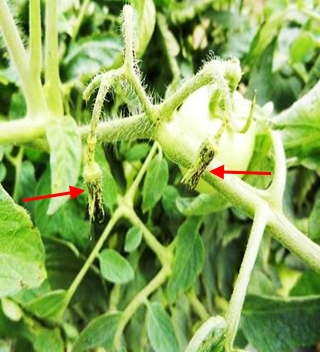Jerry Brust, IPM Vegetable Specialist, University of Maryland; jbrust@umd.edu
There are several bacterial diseases that are turning up in many Maryland tomato fields this year. The wet weather we had in June (2-4X as much rain as normal) resulted in the spread of some of our worst bacterial diseases: bacterial spot Xanthomonas campestris pv. vesicatoria, bacterial canker Clavibacter michiganensis pv. michiganensis and less common bacterial speck Pseudomonas syringae pv. tomato. Most tomato fields I have looked at in the last 3-4 weeks seem to have at least some if not a considerable amount of bacterial spot disease in them that has moved from leaves (Fig. 1) onto the pedicels and flowers (Fig. 2). Infection of the flower or pedicel with bacterial spot is serious, causing early blossom drop. From the pedicel the next stop for the bacteria, after a heavy thundershower, will be the fruit. The other commonly encountered bacterial disease is bacterial canker. This disease is a real yield killer and is difficult to manage once it gets into a field. Unfortunately 2015 seems to be an especially bad year for the disease, as was last year. A concern I have that this bacterial problem seems to be getting worse each year we have had an extended wet period. There are two main types of infections from this bacterial disease. A systemic infection of plants where leaflets of the oldest leaves curl, yellow, turn brown and collapse and plants usually grow poorly and wilt (Fig. 3). In addition dark streaks may develop on stems and branches break off easily. Secondary infections most commonly consist of the leaf margins turning yellow and then brown and almost black (Fig. 3). Bacterial canker symptoms on fruit appear as yellow to brown spots surrounded by a white halo — “bird’s eye spot”.
I have seen these bacterial disease problems (especially canker) continue on farms that seemed to have followed all the recommended management practices for control of bacterial spot and canker (i.e. rotate fields out of solanaceous crops for 2-3 years, clean and sanitize stakes and farm equipment and use certified seed). Now the question becomes, What else needs to be done to stop/slow the spread of these diseases on a farm? One thing many growers have told me, although not in all cases, is that their seed is no longer heat treated. I am not saying this must be the source of the bacterial diseases, I do not know the source of the diseases for the different farms, but clean seed is certainly one component of an integrated management program for bacterial diseases that needs to be considered. The other potential sources of the bacterial infections besides the seed that need special attention include making sure there are no tomato volunteers or Solanaceous weeds like night shade left in rotated fields during the ‘non-crop’ years. These alternative hosts can still become infected and propagate the bacterial diseases each season. Making sure any field equipment and stakes have been cleaned and sanitized very well is also important. I have noticed that growers that integrate Actigard into their spray programs appear to have fewer problems with bacterial diseases than growers who use the same spray programs without Actigard (although it may be that these growers just have different overall management programs for bacterial diseases). All of these management practices will help reduce the incidence of the bacterial diseases. It also may be that there are other overlooked, but important sources of these bacterial diseases that will need to be examined more closely in the coming seasons.
Figure 1. Bacterial spot on a tomato leaflet
Figure 2. Bacterial spot on tomato pedicels and flowers, which will cause blossom drop
Figure 3. Bacterial canker on tomato in late July



